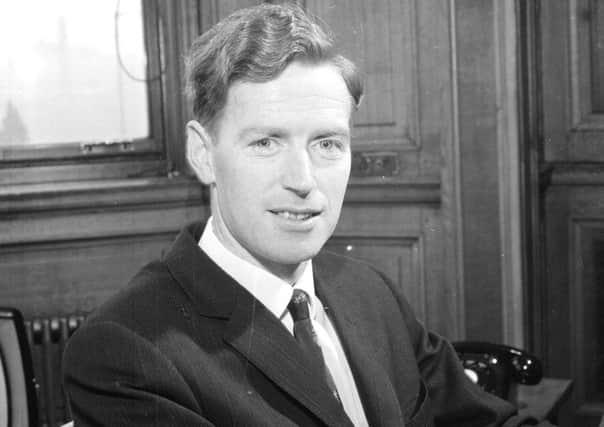David King Snedden: Former managing director of The Scotsman Publications


A man of principle and strong views, Snedden demanded the highest standards from the newspapers he ran, and his name is associated with quality publications wherever his career took him.
Snedden was born in Grangemouth in 1933 and educated at Daniel Stewart’s College, Edinburgh, where it was discovered he had a way with numbers. Accountancy beckoned, but after qualifying as a CA in Edinburgh, his career was put on hold for National Service.
Advertisement
Hide AdAdvertisement
Hide AdIt would have been easy for him to drive a desk in the Pay Corps, but his sense of adventure took him into pilot officer training with the newly-formed Nato Pilot programme in Canada, where he won the Sword of Honour as top officer cadet. He flew Harvard MK IVs and qualified on T-33 Shooting Star fighter jets, and he always maintained that National Service kickstarted his life.
Canada whetted his taste for adventure. When he wasn’t flying, he ranged far and wide, often in a superannuated Oldsmobile, developed a passion for wilderness, took up skiing, and in a long-range leave challenge reached Las Vegas by bluffing his way onto USAF resupply flights. Snedden lived the young, live-for-the-moment fighter pilot to the hilt.
When his National Service ended the adventure ebbed. He spent an unexciting year with Guinness Mahon, and became frustrated as his ideas were repeatedly rejected. He was invited to apply for the job of chief accountant at The Scotsman Publications and was interviewed by its new owner, the plain-speaking Canadian Roy Thomson, later Lord Thomson of Fleet, whose recent controversial takeover of The Scotsman – a revered Capital institution in those days – had the great and good of Edinburgh in a flutter.
Chance played its part. Snedden arrived, aged 25, in a double-breasted suit purchased at a recent Harrods sale. Thomson wore an identical suit from the same sale. Parsimony was second nature to Thomson – he liked what he saw in this ambitious young man, and when he commented that he was very young to apply for such a senior post, Snedden’s forthright answer of “Do you want age or ability?” won him the day, and his newspaper career was well and truly launched.
He had entered the newspaper world at a volatile period of great change. Although a cherisher of tradition as well as increased profits, Snedden was nonetheless a moderniser, a forward and deep thinker, and actively sought new approaches and solutions to long-standing newspaper problems. Staff saw him as formal, distant and uncompromising, but also fair, ‘tough as nails, honest as the day’, as one senior executive described him. All agreed he provided strong, clear leadership.
In 1967, he was appointed managing director of the Belfast Telegraph, one of the most influential newspapers in Ulster. It was the early years of The Troubles and in spite of the paper’s moderate political line death threats were attracted. They merely hardened Snedden’s resolve to reject any form of intimidation.
During his tenure, the paper was first to publish political opinion polls, which directly influenced the calling of the election in Northern Ireland in 1969.
In 1970, Snedden returned to Edinburgh to become managing director of The Scotsman Publications. The Scotsman reached its highest circulation during his time, and he broke new ground by forming a syndicate to secure the franchise for the competing media of Radio Forth. He moved into new areas of sponsorship, and The Scotsman-sponsored rallying team came third at Monte Carlo, and sister newspaper the Edinburgh Evening News launched the Edinburgh Marathon and the Festival Cavalcade, the parade along Princes Street as opener of the International Festival.
Advertisement
Hide AdAdvertisement
Hide AdSnedden’s success took him to London as assistant managing director of Thomson Regional Newspapers, soon followed by his appointment as joint managing director. But he missed the hands-on running of a daily newspaper, and when he was head-hunted by what was to become the Trinity International Group in Liverpool as its chief executive, Snedden saw it as his escape.
It was another rough baptism. The Liverpool papers were bedevilled by industrial relations problems, which he had to solve to progress. The Toxteth Riots confirmed to him that the Post and Echo required urgent modernisation, and the evening paper took the bold step of changing its Conservative stance to Social Democratic. The circulation increased.
His interests in newspaper community involvement saw him hire Concorde to fly sponsors and advertisers from London to Liverpool to raise the profiles of Aintree and the Grand National, and simultaneously readers were treated with a flight to Iceland and back. It proved so popular that two Concordes were required.
In 1993, Snedden retired to the Highlands near Boat of Garten. As a young man, he hid his youthful, sandy good looks behind a front of formality, yet his close friends knew an entirely different David Snedden: fun-loving family man, rugby and football enthusiast, keen golfer, walker, lover of the outdoors, a game fisherman of artistry – and record catches – on the Spey, in North Uist and Harris.
He never forgot his time in his Shooting Star jet in Canada, as well as the team spirit he found there. He translated it into the business and personal credo for life which defined him: aim high, shoot straight, build your team – and friendships – with care, accept calculated risk, develop integrity, and it brought him significant success.
The loss of his beloved daughter Ann, in 2007, sat heavily on him. He leaves his second wife Jane, two sons and five grandchildren.
IAN NIMMO